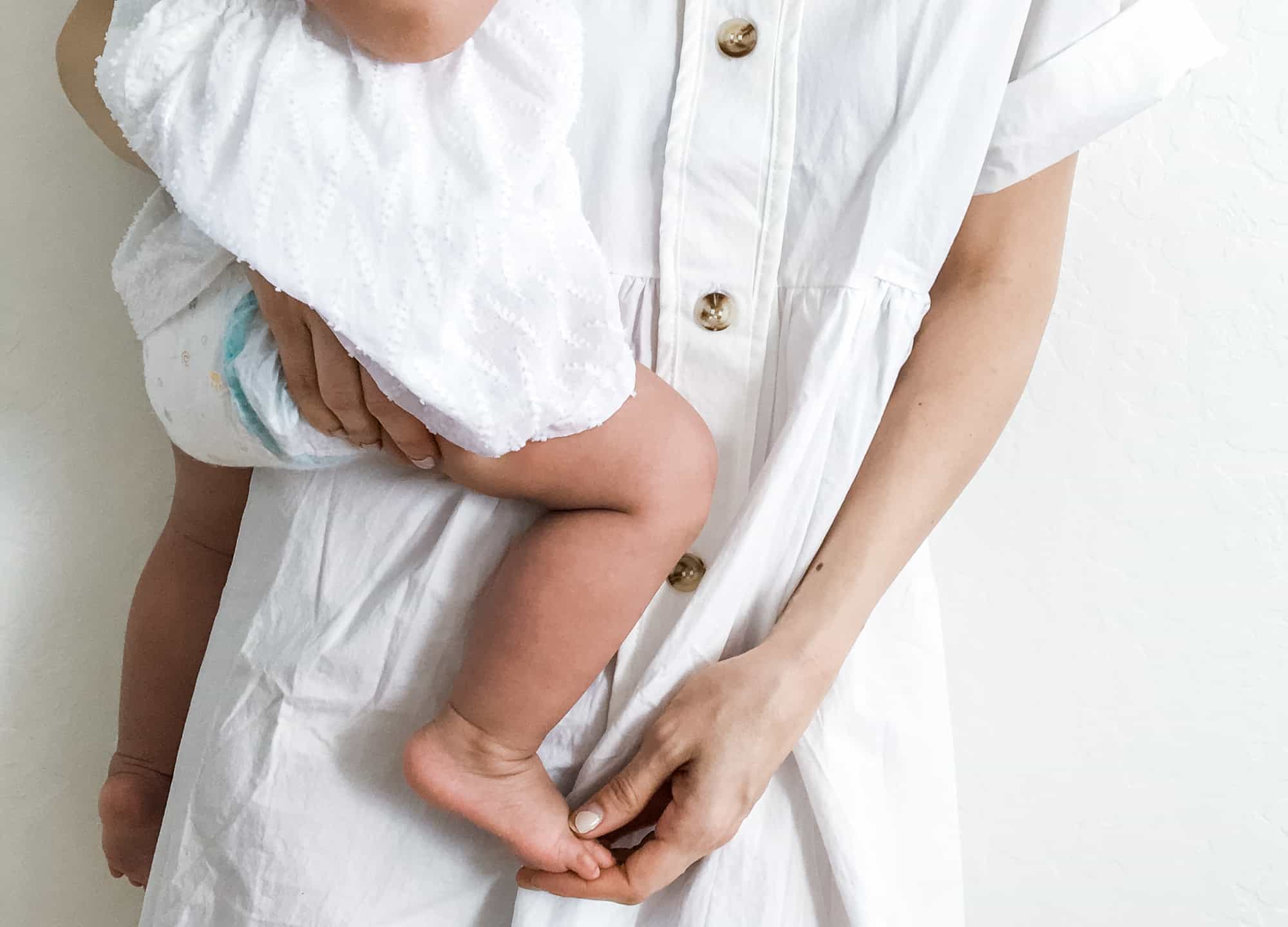There’s no shortage of avenues to motherhood, many of which don’t involve the physical components of pregnancy and childbirth. (We’d also argue that you can be a mother to babies with four paws.) That being said, as any woman who has physically carried and birthed a child will tell you, the experience inevitably impacts the body in lasting ways. “So often, the focus for women is all about getting back to where they were before babies. I get it, I went through it,” says Dr. Kelly Killeen, a board-certified plastic surgeon in Beverly Hills, California. “But that’s a profoundly unhealthy attitude. It’s really important to find a place of acceptance that your body is going to be different after babies and that’s okay. You’re not going to look the same, but you’re still going to look great,” she says.
And if you want a little extra help getting there, there are plenty of cosmetic procedures that can help address these post-baby changes, if and when you want to. Just remember that there’s no rush, advises Dr. Killeen. “You just birthed a human. Enjoy your baby. All of these procedures will be there for you as adjunctive things that can make you feel even happier and healthier, once you’re ready.”
Here, the best solutions for some of the most common concerns for moms.
Concern: loose skin on the stomach
Procedure: tummy tuck
“The most common complaint I hear from patients post-pregnancy is laxity of the skin on the abdomen,” says Dr. Michele Koo, a board-certified plastic surgeon in St. Louis. It’s not surprising, given how much the skin stretches in order to accommodate a growing baby bump; sometimes it snaps back, but oftentimes it doesn’t, leaving women with excess skin that they simply can’t get rid of.
“You can get back in shape, but there’s nothing you can do for that loose skin,” points out Dr. Farah Naz Khan, a board-certified plastic surgeon in Dallas. “Many women also have a separation of the muscles, known as diastasis recti. A tummy tuck is the best way to tighten the core, remove excess skin, and contour the abdominal wall.” (She adds that approximately 80% of her tummy tuck patients are moms.)
Just keep in mind that a tummy tuck isn’t something to schedule immediately postpartum. Ideally, the best course of action for any type of surgical skin tightening is to wait until you are done having children, notes Dr. Killeen. (However, if you don’t want to wait or happen to get pregnant after a tummy tuck, that’s not the end of the world; just know that your results may change.) She recommends waiting a minimum of six months post-birth. “You have to allow your body to do its thing. It really has an impressive ability to heal. Some women have lots of loose skin immediately after pregnancy, then six months later, they look pretty good,” she says. You should also be at a comfortable and healthy weight. “That doesn’t mean your pre-pregnancy weight, because almost no one gets back to that, but rather a weight that feels good for you and you can maintain,” she clarifies. Dr. Koo agrees, though she counsels her patients to wait at least a full year.
Delaying a tummy tuck can also play a role in the recovery process. “A tummy tuck is a major surgery, and particularly if muscle repair is involved, I tell my patients they can’t lift anything more than 10 pounds for six weeks after,” notes Dr. Khan. You either need to have full-time help at the ready or wait until your child or children are slightly more independent and don’t need to be held all the time, she points out.
Alternative: BodyTite
While surgically removing loose, excess skin is the most effective option, there are less invasive alternatives available, for women who either don’t want to have surgery or simply don’t have that much skin laxity. BodyTite—a minimally invasive, radiofrequency skin tightening treatment—is one of the best. “We do a fair amount of BodyTite on women who fall into that in-between area, where they have a little excess skin but not enough for a tummy tuck. In that case, a combination of BodyTite and liposuction on the lower abs can really tighten up the tummy,” says Dr. Khan. Dr. Killeen also says BodyTite is a good option for the right candidate, noting that, unlike with a tummy tuck, there’s no major scar (just a few small incisions) and downtime is usually only a few days, always a boon for busy moms.
Concern: sagging breasts
Procedure: breast lift or breast augmentation
Post-baby breast changes are another big area of concern for moms. Breastfeeding and hormonal swings lead to all kinds of changes, although, according to Dr. Killeen, they’re not always what women perceive them to be. “Patients tell me they’ve lost volume in their breasts, but that’s usually not the case. Breastfeeding makes the skin stretch. If it doesn’t stretch back, then everything droops,” she explains. It makes women feel like their breasts are smaller, even though the overall volume isn’t actually much less. That’s even more so because they’ve gotten used to the large, engorged breasts they had while pregnant and breastfeeding, she notes.
If the skin hasn’t stretched to the point where the nipple is below the inframammary fold, Dr. Koo says, a breast augmentation alone is usually sufficient, as inserting an implant can offer a slight lift as well. (However, she notes that it’s important to wait at least three to six months after you’re done breastfeeding in order for the glandular breast tissue to normalize.) Dr. Killeen adds that implants also have the advantage of replenishing the volume that women feel they’ve lost and creating a very consistent shape.
Procedure: mommy makeover
The aptly named treatment simply means that you’re doing something to both the breasts and the tummy at the same time, explains Dr. Khan. “This could be a breast lift, a breast augmentation, a tummy tuck, liposuction, or any pairing of the two.” Undergoing both simultaneously not only allows women to recover in one fell swoop, it’s also important for achieving the best end result. Treating the entire torso as one ensures everything looks proportionate. If you have a tummy tuck and remove a lot of excess skin but don’t do anything to sagging breasts, they will just look droopier compared to your newly flat tummy—and vice versa, Dr. Khan notes.
Concern: stretch marks
Procedure: RF microneedling (kind of)
All the experts were quick to note that there really is no way to get rid of stretch marks. “If I had a magic cure, I’d be a billionaire,” jokes Dr. Killeen. “Stretch marks occur when there’s a fracture of the dermis, and that simply can’t be fixed. All the treatments out there are focused on addressing the color or texture difference in the skin, to simply make the stretch marks less noticeable.” To that point, while radiofrequency microneedling doesn’t get rid of them, it can help lighten darker stretch marks, adds Dr. Khan. She likes Morpheus8 for this purpose, noting that four sessions, spaced a month apart, are usually needed. However, she’s quick to note that for lighter-colored stretch marks, this, not to mention anything else out there, isn’t going to be particularly effective.
Doctors are split as to whether preventing pregnancy stretch marks is possible. Dr. Kileeen says no, but Dr. Koo disagrees. “You can’t prevent them all, but you can help lessen the severity of them by taking care of and moisturizing the skin,” she says. According to Dr. Dendy Engelman, a board-certified dermatologist in New York City, “Keeping your skin hydrated is the biggest component in getting the skin on the belly ready to stretch,” she says. Her preferred method is with oils; calendula extract, lavender oil, rosemary oil, purcellin oil, and chamomile oil are all safe to use during pregnancy, she notes. “When I was pregnant, I loved using Bio-Oil ($30). I used it twice daily and have no stretch marks,” she says.
Concern: spider veins
Procedure: sclerotherapy
“Pregnancy puts pressure on the entire venous system, impeding blood flow from the legs to the heart. The pressure can cause spider veins,” explains Dr. Killeen. Sclerotherapy is the best treatment. A solution is injected into the vein, forcing it to collapse and stopping blood flow. The vein will turn into a scar and fade after a few weeks, says Dr. Engleman, who adds that most people see a 50–90% improvement. However, this is best reserved for smaller veins under the skin. For larger (more than five millimeters) ones that are raised and bumpy, surgical removal (performed by a vascular surgeon) is the way to go.
Concern: melasma
Procedure: lasers
There’s a good reason melasma is often called the mask of pregnancy. Hormonal changes lead to increased sun sensitivity, causing hyperpigmentation to form in patches on the skin of the face, the belly, and other areas, says Dr. Engelman. (Melasma that occurs during pregnancy is also referred to as chloasma.) It can’t be treated, but it can be managed: “The key is to control the things you can, sun exposure being number one,” says Dr. Killeen. This is another situation where a good defense is the best offense—namely, being extra diligent about sunscreen use while you’re pregnant, says Dr. Engleman, who recommends mineral sunscreens.
Treating melasma during pregnancy can be tough, given that many of the gold-standard pigmentation-fading topicals, such as hydroquinone and retinoids, are off limits, though Dr. Engelman says glycolic acid–based products can help fade some of the discoloration. Afterward, the PicoSure laser is great for addressing pigment, she adds; Dr. Killeen says Clear + Brilliant also tends to work well for melasma. Be patient too. So long as you’re wearing sunscreen, melasma may continue to fade on its own for a good six months postpartum as your hormones continue to normalize, Dr. Koo points out.
Concern: hair loss
Postpartum hair loss can be alarming, but, according to Dr. Engelman, there’s no need to panic. It’s an instance of telogen effluvium, a form of diffuse hair loss many women experience after giving birth, she says. “The shock of giving birth triggers more hair follicles to enter the telogen, or resting, phase of the growth cycle, resulting in lots of hair shedding at one time,” she explains. This typically occurs three to six months post-birth. The good news? Your hair will return to its normal growth pattern within a few months. While you wait, you can consider a hair-growth supplement, though you should always clear that with your doctor, especially if you’re breastfeeding, says Dr. Engelman. Otherwise, using strengthening and volumizing hair products, to prevent any additional fallout, and good old-fashioned patience are your best bets.
Concern: vaginal laxity
Procedure: introitus tightening
Particularly for women who have had a difficult delivery and/or an episiotomy, surgical tightening on the vaginal introitus, the opening to the vagina, can be very helpful, says Dr. Koo. However, she and the other surgeons note that they always perform this—and any other kind of vaginal rejuvenation—in conjunction with an OB-GYN or gynecological surgeon. Recovery can take anywhere from 6 to 12 weeks and should always incorporate pelvic floor therapy in order to maximize the results, she adds. (It also bears mentioning that this is not as extensive as a full-on vaginoplasty, during which both the vaginal canal and the levator, aka kegel, muscles are tightened.)
For those looking for a nonsurgical alternative, ThermiVa, a radiofrequency-based treatment, is an option. It can address skin laxity along the vaginal wall and labia majora—as well as urinary control, oftentimes also an issue for women post-baby)—though it doesn’t work on the muscles. Multiple sessions are needed, though they take only 30 minutes, and there’s no downtime.











